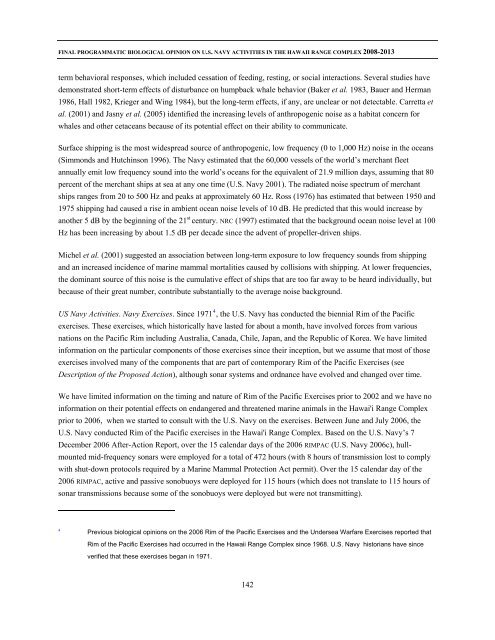NMFS Biological Opinion on U.S. Navy training ... - Govsupport.us
NMFS Biological Opinion on U.S. Navy training ... - Govsupport.us
NMFS Biological Opinion on U.S. Navy training ... - Govsupport.us
Create successful ePaper yourself
Turn your PDF publications into a flip-book with our unique Google optimized e-Paper software.
FINAL PROGRAMMATIC BIOLOGICAL OPINION ON U.S. NAVY ACTIVITIES IN THE HAWAII RANGE COMPLEX 2008-2013<br />
term behavioral resp<strong>on</strong>ses, which included cessati<strong>on</strong> of feeding, resting, or social interacti<strong>on</strong>s. Several studies have<br />
dem<strong>on</strong>strated short-term effects of disturbance <strong>on</strong> humpback whale behavior (Baker et al. 1983, Bauer and Herman<br />
1986, Hall 1982, Krieger and Wing 1984), but the l<strong>on</strong>g-term effects, if any, are unclear or not detectable. Carretta et<br />
al. (2001) and Jasny et al. (2005) identified the increasing levels of anthropogenic noise as a habitat c<strong>on</strong>cern for<br />
whales and other cetaceans beca<strong>us</strong>e of its potential effect <strong>on</strong> their ability to communicate.<br />
Surface shipping is the most widespread source of anthropogenic, low frequency (0 to 1,000 Hz) noise in the oceans<br />
(Simm<strong>on</strong>ds and Hutchins<strong>on</strong> 1996). The <strong>Navy</strong> estimated that the 60,000 vessels of the world’s merchant fleet<br />
annually emit low frequency sound into the world’s oceans for the equivalent of 21.9 milli<strong>on</strong> days, assuming that 80<br />
percent of the merchant ships at sea at any <strong>on</strong>e time (U.S. <strong>Navy</strong> 2001). The radiated noise spectrum of merchant<br />
ships ranges from 20 to 500 Hz and peaks at approximately 60 Hz. Ross (1976) has estimated that between 1950 and<br />
1975 shipping had ca<strong>us</strong>ed a rise in ambient ocean noise levels of 10 dB. He predicted that this would increase by<br />
another 5 dB by the beginning of the 21 st century. NRC (1997) estimated that the background ocean noise level at 100<br />
Hz has been increasing by about 1.5 dB per decade since the advent of propeller-driven ships.<br />
Michel et al. (2001) suggested an associati<strong>on</strong> between l<strong>on</strong>g-term exposure to low frequency sounds from shipping<br />
and an increased incidence of marine mammal mortalities ca<strong>us</strong>ed by collisi<strong>on</strong>s with shipping. At lower frequencies,<br />
the dominant source of this noise is the cumulative effect of ships that are too far away to be heard individually, but<br />
beca<strong>us</strong>e of their great number, c<strong>on</strong>tribute substantially to the average noise background.<br />
US <strong>Navy</strong> Activities. <strong>Navy</strong> Exercises. Since 1971 4 , the U.S. <strong>Navy</strong> has c<strong>on</strong>ducted the biennial Rim of the Pacific<br />
exercises. These exercises, which historically have lasted for about a m<strong>on</strong>th, have involved forces from vario<strong>us</strong><br />
nati<strong>on</strong>s <strong>on</strong> the Pacific Rim including A<strong>us</strong>tralia, Canada, Chile, Japan, and the Republic of Korea. We have limited<br />
informati<strong>on</strong> <strong>on</strong> the particular comp<strong>on</strong>ents of those exercises since their incepti<strong>on</strong>, but we assume that most of those<br />
exercises involved many of the comp<strong>on</strong>ents that are part of c<strong>on</strong>temporary Rim of the Pacific Exercises (see<br />
Descripti<strong>on</strong> of the Proposed Acti<strong>on</strong>), although s<strong>on</strong>ar systems and ordnance have evolved and changed over time.<br />
We have limited informati<strong>on</strong> <strong>on</strong> the timing and nature of Rim of the Pacific Exercises prior to 2002 and we have no<br />
informati<strong>on</strong> <strong>on</strong> their potential effects <strong>on</strong> endangered and threatened marine animals in the Hawai'i Range Complex<br />
prior to 2006, when we started to c<strong>on</strong>sult with the U.S. <strong>Navy</strong> <strong>on</strong> the exercises. Between June and July 2006, the<br />
U.S. <strong>Navy</strong> c<strong>on</strong>ducted Rim of the Pacific exercises in the Hawai'i Range Complex. Based <strong>on</strong> the U.S. <strong>Navy</strong>’s 7<br />
December 2006 After-Acti<strong>on</strong> Report, over the 15 calendar days of the 2006 RIMPAC (U.S. <strong>Navy</strong> 2006c), hullmounted<br />
mid-frequency s<strong>on</strong>ars were employed for a total of 472 hours (with 8 hours of transmissi<strong>on</strong> lost to comply<br />
with shut-down protocols required by a Marine Mammal Protecti<strong>on</strong> Act permit). Over the 15 calendar day of the<br />
2006 RIMPAC, active and passive s<strong>on</strong>obuoys were deployed for 115 hours (which does not translate to 115 hours of<br />
s<strong>on</strong>ar transmissi<strong>on</strong>s beca<strong>us</strong>e some of the s<strong>on</strong>obuoys were deployed but were not transmitting).<br />
4<br />
Previo<strong>us</strong> biological opini<strong>on</strong>s <strong>on</strong> the 2006 Rim of the Pacific Exercises and the Undersea Warfare Exercises reported that<br />
Rim of the Pacific Exercises had occurred in the Hawaii Range Complex since 1968. U.S. <strong>Navy</strong> historians have since<br />
verified that these exercises began in 1971.<br />
142








